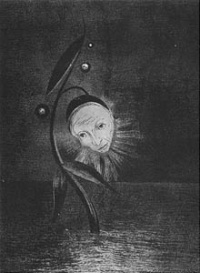Sadness
From The Art and Popular Culture Encyclopedia
_-_Edgar_Degas.jpg)

|
Related e |
|
Featured: |
Sadness is an emotion characterized by feelings of disadvantage, loss, and helplessness. When sad, people often become quiet, less energetic, and withdrawn. Sadness is considered to be the opposite of happiness, and is similar to the emotions of sorrow, grief, misery, and melancholy. The philosopher Baruch Spinoza defined sadness as the “transfer of a person from a large perfection to a smaller one.”
Sadness can be viewed as a temporary lowering of mood (feeling blue), whereas clinical depression is characterized by a persistent and intense lowered mood, as well as disruption to one's ability to function in day to day matters.
Etymology
From Middle English sad, from Old English sæd (“sated with, weary of, satiated, filled, full”), from Proto-Germanic *sadaz (“sated, satisfied”), from Proto-Indo-European *seh₂- (“to satiate, satisfy”). Cognate with West Frisian sêd, Dutch zat (“sated, drunk”), German satt (“well-fed, full”), Danish sat, Norwegian sad, Gothic (saþs, “full, satisfied”), and through Indo-European, with Latin satur (“well-fed, sated”). Related to sate.
See also
- Depression (mood)
- Melancholia
- Happiness
- Mood (psychology)
- After Laughter (Comes Tears), a song by Wendy Rene
- Bonjour tristesse, a novel by Sagan


